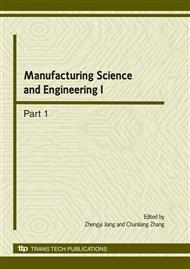[1]
Ü. Özgür, Ya.I. Alivov, C. Liu, A. Teke, M.A. Reshchikov, S. Doğan, V. Avrutin, S. -J. Cho, and H. Morkoc: J Appl Phys Vol. 98 (2005), p.041301.
DOI: 10.1063/1.1992666
Google Scholar
[2]
N. Hasuike, K. Nishio, T. Isshiki, K. Kisoda, and H. Harima: Phys. Stat. Sol. Vol. 6 (2009), p.213.
Google Scholar
[3]
T. Dietl, H. Ohno, F. Matsukura, J. Cibért, and D. Ferrand: Science Vol. 287 (2000), p.1019.
Google Scholar
[4]
K. Sato and H. Katayama-Yoshida: Jpn.J. Appl. Phys. Vol. 39 (2000), p. L555.
Google Scholar
[5]
K. Ueda, H. Tabata, and Kawai: Appl. Phys. Lett. Vol. 79 (2001), p.988.
Google Scholar
[6]
Z. Yin, N. Chen, C. Chai, and F. Yang: J. Appl. Phys. Vol. 96 (2004), p.5093.
Google Scholar
[7]
H. Zhou, D.M. Hofmann, A. Hofstaetter, and B.K. Meyer: J. Appl. Phys. Vol. 94 (2003), p. (1965).
Google Scholar
[8]
S. Deka and P.A. Joy: Appl. Phys. Lett. Vol. 89 (2006), p.032508.
Google Scholar
[9]
J. Cui, Q. Zeng, and U.J. Gibson: J. Appl. Phys. Vol. 99 (2006), p. 08M113.
Google Scholar
[10]
W.L. Yang, X.L. Wu, T. Qiu, G.G. Siu, and P.K. Chu: J. Appl. Phys. Vol. 99 (2006), p.074303.
Google Scholar
[11]
T. Fukumura, Z. Jin, M. Kawasaki, T. Shono, T. Hasegawa, and S. Koshihara: Appl. Phys. Lett. Vol. 78 (2001), p.958.
DOI: 10.1063/1.1348323
Google Scholar
[12]
A. Tiwari, C. Jin, A. Kvit, D. Kumar, J.F. Muth, and J. Nrayan: Solid State Commun. Vol. 121 (2002), p.371.
Google Scholar
[13]
S.W. Jung, S.J. An, G. Yi, U. Jung, S. Lee, and S. Cho: Appl. Phys. Lett. Vol. 80 (2002), p.4561.
Google Scholar
[14]
S. Kuroda, N. Nishizawa, K. Takita, M. Mitome, Y. Bando, K. Osuch, and T. Dietl: Nature Materials Vol. 6 (2007), p.440.
DOI: 10.1038/nmat1910
Google Scholar
[15]
T.C. Damen, S.P.S. Porto, B. Tell: Phys. Rev. Vol. 142 (1966), p.570.
Google Scholar
[16]
T.S. Jeong, M.S. Han, C.J. Youn, and Y.S. Park: J. Appl. Phys. Vol. 96 (2004), p.175.
Google Scholar
[17]
X.B. Wang, C. Song, K.W. Geng, F. Zeng, and F. Pan: Applied Surface Science Vol. 253 (2007), p.6905.
Google Scholar
[18]
C. Sudakar, J.S. Thakur, G. Lawes, R. Naik, and V.M. Naik: Phys. Rev. B Vol. 75 (2007), p.054423.
Google Scholar
[19]
H.J. Lee, B.S. Kim, C.R. Cho, and S.Y. Jeong: Phys. Status Solidi B Vol. 241 (2004), p.1533.
Google Scholar
[20]
A. B. Djurisic and Y. H. Leung: Small Vol. 2(8-9) (2006), p.944.
Google Scholar
[21]
A.A. Sokol, S.A. French, S.T. Bromley, C.R.A. Catlow, H.J.J. van Dam, and P. Sherwood: Faraday Discussions Vol. 134 (2007), p.267.
DOI: 10.1039/b607406e
Google Scholar


